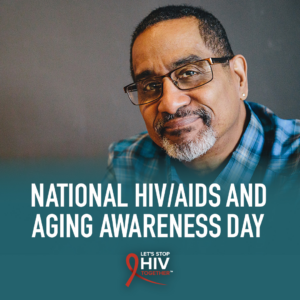 National HIV/AIDS and Aging Awareness Day (NHAAD) is recognized annually on September 18th to bring attention to the growing number of people living long and full lives with HIV. The awareness day also calls attention to the unique health and social needs/challenges of HIV prevention, testing, treatment, and care in older adults.
National HIV/AIDS and Aging Awareness Day (NHAAD) is recognized annually on September 18th to bring attention to the growing number of people living long and full lives with HIV. The awareness day also calls attention to the unique health and social needs/challenges of HIV prevention, testing, treatment, and care in older adults.
This presents a good opportunity to educate or remind older adults about the risk factors of HIV and emphasize the importance of HIV testing. Testing gives individuals the information they need to either access HIV prevention services (PrEP), or be linked to HIV treatment services to improve health outcomes.
Most risk factors for HIV are the same, regardless of age. However, older people may not be aware of the HIV risk factors. In the United States, HIV is spread mainly by:
- Having anal or vaginal sex with someone who has HIV without using a condom and/or not taking medicines to prevent HIV (PrEP)
- Having unprotected sex with numerous partners of unknown HIV status
- Having frequent STIs/STDs
- Sharing injection drug equipment with someone who has HIV
HRSA recommends that everyone ages 15 to 64 get tested for HIV, at least once, as part of routine health care. For individuals at higher risk of HIV, more frequent testing is recommended.
Older people are generally considered at low risk of getting HIV. Some older people may be embarrassed or afraid to be tested for HIV. Signs of HIV may be mistaken for symptoms of age-related conditions. Consequently, testing to diagnose a specific condition may not include HIV testing. However, in 2021, 16% of the newly diagnosed HIV cases were individuals over the age of 55.
For these reasons, HIV is more likely to be diagnosed at an advanced stage in many older people. Diagnosing HIV at a late stage also means a late start to treatment with HIV medications and possibly more damage to the immune system.
A significant percentage of adults over 50 living with HIV were diagnosed in the 80s and early 90s. At that time, most HIV-positive individuals were instructed to “go home and put your affairs in order” as they were not expected to live more than a year with this complicated infection. That was due to the lack of effective treatment options.
Today, thanks to significant improvements in HIV treatment medication (called antiretroviral therapy or ART), people with HIV who are diagnosed early get and stay on ART and can keep the virus suppressed and live long and healthy lives. For this reason, half of the people living with diagnosed HIV in the United States are aged 50 and older. Experts estimate that by 2030 70% of individuals living with HIV (In the US) will be over 50 years old.
For many long-term survivors, HIV is the least of their challenges. Because the virus is mostly controlled, many are faced with managing health conditions associated with “Normal Aging” and the related health effects of decades of living with HIV and its treatments. This may include an increased risk of a cancer diagnosis. Providers can adapt cancer prevention strategies by providing earlier cancer screenings, especially for anal, oral, and head and neck cancers that disproportionately affect older Americans with HIV.
We encourage everyone to talk to your healthcare provider about your risk of HIV and ways to reduce your risk. Don’t have a health care provider? Northwest Health Services’ Providers are accepting new patients at this time.
Also, Northwest Health Services offers free HIV rapid tests at all of our medical locations. This test is simple and results are available in about 20 minutes. For more information regarding testing or HIV prevention and/or treatment, please contact Janet Miller, HIV Prevention Specialist/Case Manager at 816-901-1034.
